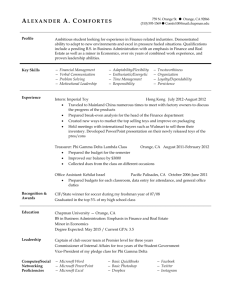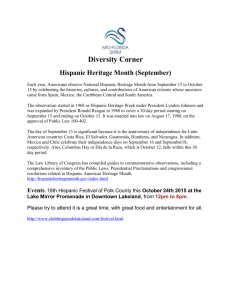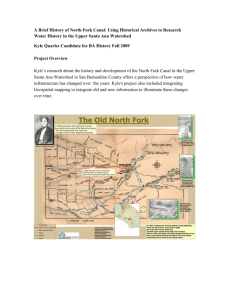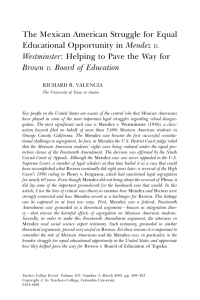Ranchos provide basis for large landholdings – Irvine, O`Neill, Bixby
advertisement
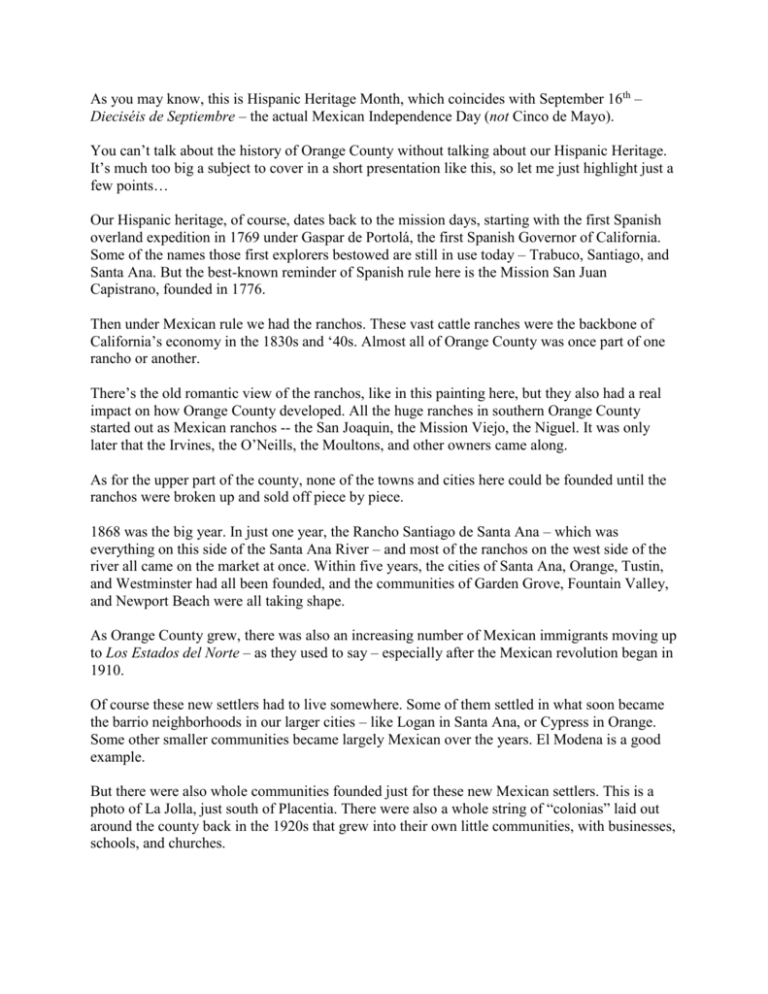
As you may know, this is Hispanic Heritage Month, which coincides with September 16th – Dieciséis de Septiembre – the actual Mexican Independence Day (not Cinco de Mayo). You can’t talk about the history of Orange County without talking about our Hispanic Heritage. It’s much too big a subject to cover in a short presentation like this, so let me just highlight just a few points… Our Hispanic heritage, of course, dates back to the mission days, starting with the first Spanish overland expedition in 1769 under Gaspar de Portolá, the first Spanish Governor of California. Some of the names those first explorers bestowed are still in use today – Trabuco, Santiago, and Santa Ana. But the best-known reminder of Spanish rule here is the Mission San Juan Capistrano, founded in 1776. Then under Mexican rule we had the ranchos. These vast cattle ranches were the backbone of California’s economy in the 1830s and ‘40s. Almost all of Orange County was once part of one rancho or another. There’s the old romantic view of the ranchos, like in this painting here, but they also had a real impact on how Orange County developed. All the huge ranches in southern Orange County started out as Mexican ranchos -- the San Joaquin, the Mission Viejo, the Niguel. It was only later that the Irvines, the O’Neills, the Moultons, and other owners came along. As for the upper part of the county, none of the towns and cities here could be founded until the ranchos were broken up and sold off piece by piece. 1868 was the big year. In just one year, the Rancho Santiago de Santa Ana – which was everything on this side of the Santa Ana River – and most of the ranchos on the west side of the river all came on the market at once. Within five years, the cities of Santa Ana, Orange, Tustin, and Westminster had all been founded, and the communities of Garden Grove, Fountain Valley, and Newport Beach were all taking shape. As Orange County grew, there was also an increasing number of Mexican immigrants moving up to Los Estados del Norte – as they used to say – especially after the Mexican revolution began in 1910. Of course these new settlers had to live somewhere. Some of them settled in what soon became the barrio neighborhoods in our larger cities – like Logan in Santa Ana, or Cypress in Orange. Some other smaller communities became largely Mexican over the years. El Modena is a good example. But there were also whole communities founded just for these new Mexican settlers. This is a photo of La Jolla, just south of Placentia. There were also a whole string of “colonias” laid out around the county back in the 1920s that grew into their own little communities, with businesses, schools, and churches. I imagine you’ve heard the name Colonia Independencia recently as they move ahead with the annexation of that area to Anaheim, but what about Colonia Juarez just south of Mile Square Park? Or the La Paz and Manzanillo colonias near Euclid and Westminster? By 1950, there were perhaps as many as 40 of these Mexican-American neighborhoods and communities spread across all of Orange County. Some of them have retained their identity to this day. Finally, there’s the role that Orange County played in the desegregation of California’s schools. As our immigrant population increased in the 1920s, it became more and more common for school districts to set up segregated classrooms, and later entire segregated schools for the Mexican-American kids. All of this was done, of course, on the old theory of “separate but equal”. But in reality, the Mexican-American schools and the “white” schools were anything but equal. Well in 1945, Gonzalo Mendez decided to do something about it. He lived in Westminster, where his kids were expected to go to the segregated school clear across town. So he went to court to change things. The Santa Ana, Garden Grove, and El Modena school districts were later added to the list of defendants, with families of other local children as plaintiffs. The families were supported by LULAC – the League of United Latin American Citizens – and other advocacy groups, including the NAACP and the Japanese American Citizens League. The case was originally heard before Judge Paul McCormick in the District Court in Los Angeles. He ruled against the school districts. The school districts appealed to the 9th Circuit Court of Appeals – and lost. So in 1947, California became the first state in the nation to desegregate its schools. The Mendez case led the way for the famous Brown vs. Board of Education case a six years later, which desegregated schools all across the United States. Civil Rights Attorney Thurgood Marshall, who argued the Brown case, wrote an amicus brief for the Mendez appeal. And Earl Warren, who was Governor of California during the Mendez case, was Chief Justice of the U.S. Supreme Court when Brown was decided. Spanish explorers, Mexican ranchos, the Mendez case – that’s just a little taste of our local Hispanic heritage. What I think is important to remember is that these stories are part of all our history. If you’re going to really understand the significance of any group, any activity, any event in history, you have to step back, and try to see where it fits into the big picture. That’s what the County Archives is for – to give people a chance to look at the whole story of Orange County – including our rich Hispanic heritage.




